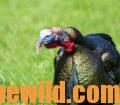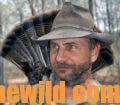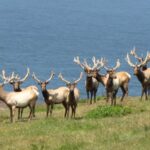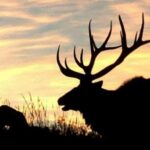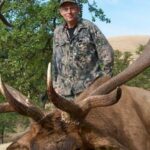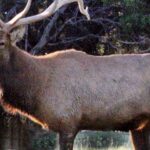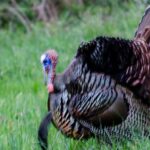Editor’s Note: No one likes to miss a turkey, but it happens. We always look for excuses to justify the misses, so we’re not implicated. However, I’ve realized that I should admit I’ve missed and not give numerous excuses of why I’ve committed the almost unpardonable sin in turkey hunting of missing my tom.
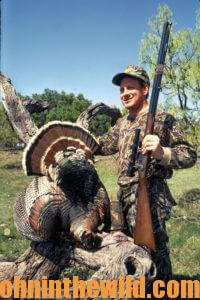 I was fortunate that my guide, Cecil Carder, had hunted this Texas property before and also was a friend of many years and a seasoned gobbler chaser. Now I could’ve blamed this miss on the blackpowder shotgun or on the plastic shot cups that I was using to replace the wadding that the shot rests on that helps push the shot out of the barrel. Back then, shot cups had proven to hold the pattern tighter than the smooth barrels of the guns we were shooting. So, the outdoor writers on this turkey hunt had enjoyed using plastic shot cups with their blackpowder shotguns.
I was fortunate that my guide, Cecil Carder, had hunted this Texas property before and also was a friend of many years and a seasoned gobbler chaser. Now I could’ve blamed this miss on the blackpowder shotgun or on the plastic shot cups that I was using to replace the wadding that the shot rests on that helps push the shot out of the barrel. Back then, shot cups had proven to hold the pattern tighter than the smooth barrels of the guns we were shooting. So, the outdoor writers on this turkey hunt had enjoyed using plastic shot cups with their blackpowder shotguns.
Only a limited number of shot cups had been brought to the hunt. The writers were concerned that they might not have enough plastic shot cups to finish the hunt. Naturally, I was inclined to help my friends out. Thinking I had shot cups in both pockets of my turkey vest, I gave away all of the shot cups on the right side pocket of my vest.
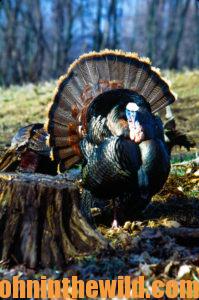 After lunch, we all loaded up in our guides’ trucks and went to different parts of the ranch to hunt turkeys. When Cecil Carder and I climbed out of his truck, Cecil said, “Go ahead, and load up, John. We may hear a turkey close by.” I then reached inside the left pocket of my turkey vest, and as my fingers probed, they touched a push-button call, a knife, a pair of gloves and insect repellant, but they never touched a plastic shot cup. I explained my dilemma to Cecil, and he was just as dumbfounded as I was.
After lunch, we all loaded up in our guides’ trucks and went to different parts of the ranch to hunt turkeys. When Cecil Carder and I climbed out of his truck, Cecil said, “Go ahead, and load up, John. We may hear a turkey close by.” I then reached inside the left pocket of my turkey vest, and as my fingers probed, they touched a push-button call, a knife, a pair of gloves and insect repellant, but they never touched a plastic shot cup. I explained my dilemma to Cecil, and he was just as dumbfounded as I was.
So, I decided to pour my measured black powder down the barrel of the shotgun and put three overshot patches on top of the black powder. Next, I poured in an equal amount of No. 6 shot on the overshot patches and finally put another overshot patch on top of the shot. Cecil was somewhat worried and said, “John, I don’t know whether that’s going to work or not.” I had to agree. But my only other option was to drive all the way back to camp and try to find some plastic shot cups that probably weren’t there. I realized that either one of three things would happen: the gun would fire, and we’d have a chance to take a turkey; the gun would fire, and I’d miss the turkey; or the gun would fire, and we might have an accident, proving that this wasn’t a good idea. But Cecil said, “Okay, let’s go.”
We had walked 1-1/2 miles before we heard a turkey gobble, which meant that we now had a turkey to hunt. As we moved closer, Cecil yelped again, and two turkeys gobbled. We only walked about 30-40 more yards and ran into a three-strand barbed wire fence. I told Cecil, “Those turkeys won’t want to cross that fence.” He responded with, “Those turkeys live out here where there are barbed wire fences wherever they go. They’ll either go under the fence or fly over it. So, we should set up about 30-40 yards away from the fence but be close enough to it to see what the turkeys do when they reach the fence.”
Now the game plan was laid. All we had to do was wait on the turkeys. In about five minutes or less, we spotted three longbeard gobblers at the fence. They walked back and forth, trying to decide whether to go under or to fly above the barbed wire. Finally, the biggest of the three gobblers walked off about 10-15 yards from the fence and took to the air. He didn’t gain that much altitude but flew high enough to clear the top strand of the barbed wire. The two other turkeys watched the gobbler hit the ground and started strutting. They had one of two choices. They could remain on their side of the fence, while the strutting gobbler called the hen to him and mated with her. Or, they could quickly pick a spot to run under the fence to go where the big gobbler was strutting and hope that the hen would come to them. Although the big gobbler had been strutting for a minute, he still hadn’t seen the hen. But he knew that he should’ve been close enough to see her when he started strutting. After a while, he moved off to my left, so when the other two gobblers went under the fence, he was about 30-yards away.
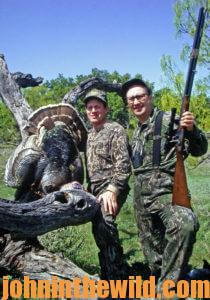 “Pick out one of the two gobblers coming from the fence and bust him,” Cecil whispered. I then aimed at the closest turkey and squeezed the trigger. The cloud of black smoke obstructed my view for a second. Then Cecil announced, “I can’t believe you killed the big gobbler off to the left. The gobbler I wanted you to shoot ran back under the fence away from us at the sound of your shot.” I knew immediately what had happened, however, in that instance, I decided a lie seemed much more appropriate than the truth. “Cecil, just before I shot, I swung a little bit to the left to get that big gobbler.” Cecil had been sitting right beside me and smiled – because he recognized my lie and said, “Hey, at least the shotgun fired, we didn’t get hurt, and we didn’t miss a turkey.” I told him, “The triple overshot wadding we put over the powder must have worked.” Cecil chuckled and said, “Yes, it did.”
“Pick out one of the two gobblers coming from the fence and bust him,” Cecil whispered. I then aimed at the closest turkey and squeezed the trigger. The cloud of black smoke obstructed my view for a second. Then Cecil announced, “I can’t believe you killed the big gobbler off to the left. The gobbler I wanted you to shoot ran back under the fence away from us at the sound of your shot.” I knew immediately what had happened, however, in that instance, I decided a lie seemed much more appropriate than the truth. “Cecil, just before I shot, I swung a little bit to the left to get that big gobbler.” Cecil had been sitting right beside me and smiled – because he recognized my lie and said, “Hey, at least the shotgun fired, we didn’t get hurt, and we didn’t miss a turkey.” I told him, “The triple overshot wadding we put over the powder must have worked.” Cecil chuckled and said, “Yes, it did.”
Both of us realized the lie I was telling. When I shot the shotgun, one or possibly two pellets had been were fliers, which meant they left the direction of travel that the rest of the shot was following for some reason and made a sharp left turn, killing the big gobbler. Probably this happened due to the weird patching system I’d created. However, for whatever reason, that twist of fate allowed me to take the boss gobbler. Now, the two subordinate gobblers would be able to continue to gobble.
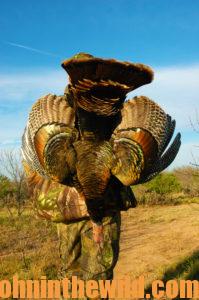 Very excited, I went into camp with a great turkey-hunting story about the bad bird I’d bagged. Unfortunately, Cecil discredited it by secretly telling everyone, “That fool put three overshot waddings on top of the black powder because he didn’t have a shot cup or the appropriate wadding. When he squeezed the trigger, I didn’t know where his shot would go once it came out of the barrel, but it scared off the two gobblers right in front of him. The two fliers that came out of that shot pattern killed the boss gobbler. Sometimes, I guess the Good Lord just smiles on fools and drunks, and I know John doesn’t drink.”
Very excited, I went into camp with a great turkey-hunting story about the bad bird I’d bagged. Unfortunately, Cecil discredited it by secretly telling everyone, “That fool put three overshot waddings on top of the black powder because he didn’t have a shot cup or the appropriate wadding. When he squeezed the trigger, I didn’t know where his shot would go once it came out of the barrel, but it scared off the two gobblers right in front of him. The two fliers that came out of that shot pattern killed the boss gobbler. Sometimes, I guess the Good Lord just smiles on fools and drunks, and I know John doesn’t drink.”
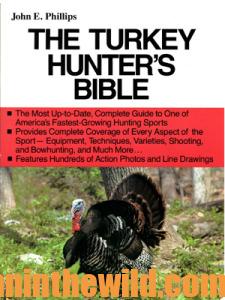 To learn more about turkey hunting, check out John E. Phillips’s book “The Turkey Hunter’s Bible,” available in print, Kindle and Audible versions at https://www.amazon.com/gp/product/B007HT1IUS/ref=dbs_a_def_rwt_hsch_vapi_taft_p1_i7. You may have to cut and paste this link into your browser. (When you click on this book, notice on the left where Amazon says you can read 10% of this book for free and hear 10% for free). To learn more about other turkey books by John E. Phillips, go to www.amazon.com/author/johnephillips.
To learn more about turkey hunting, check out John E. Phillips’s book “The Turkey Hunter’s Bible,” available in print, Kindle and Audible versions at https://www.amazon.com/gp/product/B007HT1IUS/ref=dbs_a_def_rwt_hsch_vapi_taft_p1_i7. You may have to cut and paste this link into your browser. (When you click on this book, notice on the left where Amazon says you can read 10% of this book for free and hear 10% for free). To learn more about other turkey books by John E. Phillips, go to www.amazon.com/author/johnephillips.
Tomorrow: The Man Eater Beats All Turkey Hunters

